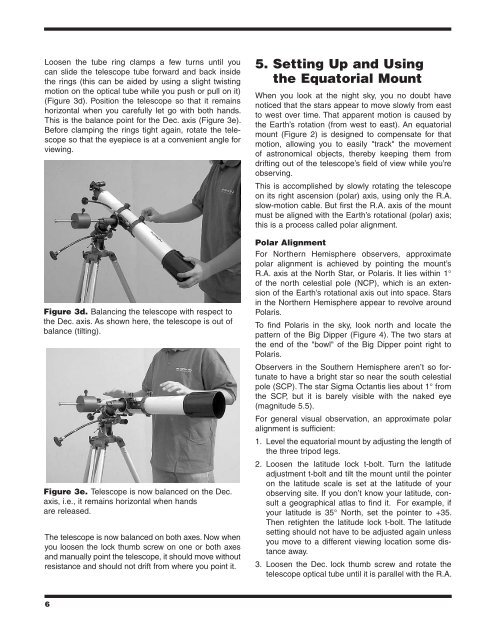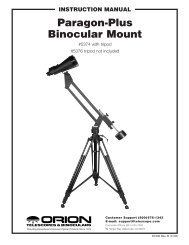Orion® EQ-1 Equatorial Mount
Orion® EQ-1 Equatorial Mount
Orion® EQ-1 Equatorial Mount
You also want an ePaper? Increase the reach of your titles
YUMPU automatically turns print PDFs into web optimized ePapers that Google loves.
Loosen the tube ring clamps a few turns until youcan slide the telescope tube forward and back insidethe rings (this can be aided by using a slight twistingmotion on the optical tube while you push or pull on it)(Figure 3d). Position the telescope so that it remainshorizontal when you carefully let go with both hands.This is the balance point for the Dec. axis (Figure 3e).Before clamping the rings tight again, rotate the telescopeso that the eyepiece is at a convenient angle forviewing.Figure 3d. Balancing the telescope with respect tothe Dec. axis. As shown here, the telescope is out ofbalance (tilting).Figure 3e. Telescope is now balanced on the Dec.axis, i.e., it remains horizontal when handsare released.The telescope is now balanced on both axes. Now whenyou loosen the lock thumb screw on one or both axesand manually point the telescope, it should move withoutresistance and should not drift from where you point it.5. Setting Up and Usingthe <strong>Equatorial</strong> <strong>Mount</strong>When you look at the night sky, you no doubt havenoticed that the stars appear to move slowly from eastto west over time. That apparent motion is caused bythe Earth’s rotation (from west to east). An equatorialmount (Figure 2) is designed to compensate for thatmotion, allowing you to easily "track" the movementof astronomical objects, thereby keeping them fromdrifting out of the telescope’s field of view while you’reobserving.This is accomplished by slowly rotating the telescopeon its right ascension (polar) axis, using only the R.A.slow-motion cable. But first the R.A. axis of the mountmust be aligned with the Earth’s rotational (polar) axis;this is a process called polar alignment.Polar AlignmentFor Northern Hemisphere observers, approximatepolar alignment is achieved by pointing the mount’sR.A. axis at the North Star, or Polaris. It lies within 1°of the north celestial pole (NCP), which is an extensionof the Earth’s rotational axis out into space. Starsin the Northern Hemisphere appear to revolve aroundPolaris.To find Polaris in the sky, look north and locate thepattern of the Big Dipper (Figure 4). The two stars atthe end of the "bowl" of the Big Dipper point right toPolaris.Observers in the Southern Hemisphere aren’t so fortunateto have a bright star so near the south celestialpole (SCP). The star Sigma Octantis lies about 1° fromthe SCP, but it is barely visible with the naked eye(magnitude 5.5).For general visual observation, an approximate polaralignment is sufficient:1. Level the equatorial mount by adjusting the length ofthe three tripod legs.2. Loosen the latitude lock t-bolt. Turn the latitudeadjustment t-bolt and tilt the mount until the pointeron the latitude scale is set at the latitude of yourobserving site. If you don’t know your latitude, consulta geographical atlas to find it. For example, ifyour latitude is 35° North, set the pointer to +35.Then retighten the latitude lock t-bolt. The latitudesetting should not have to be adjusted again unlessyou move to a different viewing location some distanceaway.3. Loosen the Dec. lock thumb screw and rotate thetelescope optical tube until it is parallel with the R.A.6



